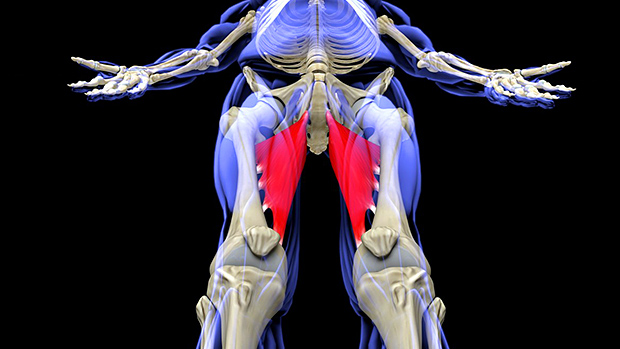It's impossible not to notice trends in the fitness world. The majority of these – like the ridiculous Ab Lounge – last for a year or so and then are either forgotten or shoved underneath the bed next to the dust balls and discarded dirty underwear.
But some trends are actually beneficial and become staples in the training programs of thousands of lifters.
Take weight-training circuits (also called "complexes") for fat-loss. When programmed properly, they have the potential to strip off fat faster than any other protocol, but when half-assed or shoddily constructed they become a giant waste of time.
This article will teach you how to set up your own advanced complexes to burn the most fat without looking like a pansy.
It's pretty straightforward: cycle through a series of exercises without putting the bar down, transitioning smoothly from movement to movement, and performing all the assigned reps on one exercise before moving to the next.
I thought all us "coaches" had a fairly good handle on it, but I was wrong.
My first indication was when I read a workout in a newsstand magazine. This complex, written by a guy who had enough letters behind his name to know better, took a completely ass-backwards approach. I wrote it off as a fluke.
Less than a week after that, I was in the gym and saw a student athlete muscle his way through what I can only assume was his version of a home-brew complex. And by that, I mean he would do a bunch of reps on one exercise, and then a bunch on another, with no real thought to the order.
Despite the great examples that can be found, like this article, I still see people absolutely ruining themselves in the gym.
Here's the issue.
The trend right now is fast-paced, interval-type weight training workouts designed for fat-loss. This is a good thing, and truth be told, these type of workouts make up a good part of my clients' programming for fat-loss.
Overall, the idea is to do as much work as possible in the shortest period of time, focusing on training speed and density.
However, when people randomly throw exercises together to create a complex, they're often not really paying attention to anything other than the idea of complexes. They're too focused on doing more work in less time to lose fat and haven't even considered if the exercises they picked were effective.
Let's say you have a guy doing the following complex:
- Deadlift
- Power Clean
- Front Squat
- Overhead Press
He's doing a lot of big movements, but is he really getting much out of some of them? Hopefully the deadlift is his strongest movement, but he can't really use a weight that's challenging since he's limited by the overhead press, which is undoubtedly weaker.
In terms of "doing a lot of stuff" in not a lot of time, this guy is on point. He's very expedient. But he's missing out on a lot since the complex isn't very effective. Or at least not as effective as it could be.
But if this guy used a different set up, he could work with a weight that's challenging for all parts of the complex and would get significantly better results.
Here's where a lot of coaches and I part ways. Many trainers who prescribe complexes are OK with the notion that your weakest exercise limits your strongest one. I consider it a limitation of basic complex design that can be completely eliminated with a bit of forethought and some ingenuity.
Going back to the example above, the weight is incredibly light for our guy to deadlift, but perfect for the overhead press. Popular training literature suggests that we shouldn't care about that, since the complex is not intended to challenge you in the same way that traditional weight training is. That is, an overly-light deadlift is of no concern, because we are deadlifting just to lose fat.
I'm calling bullshit.
Instead, what if we did twice as many deadlifts as overhead presses or only used exercises where the weight was appropriate for the same number of reps on each?
What I'm about to show you aren't regular complexes. They're advanced. Or as I like to call them, Complexes 2.0.
But first, let's look at some of the problems with current complexes.
1 Too Much Focus on Uniformity of Reps
I have no idea where it came from, but there seems to be some unwritten rule that when you perform a complex, you need to do the same number of reps for each exercise. Sure, it's one way to do it, but it's only effective if that same weight is equally challenging on all of the selected exercises.
2 Improper Exercise Selection
It's more effective to have the weight be equally challenging on all exercises. So if you're not going with a variable rep method like I mentioned above, it's better to select exercises that require an equal level of intensity to perform.
3 Improper Exercise Order
I can't stress enough the importance of properly ordering exercises for maximizing the effectiveness of your complexes. Throwing presses, cleans, squats and deads together in any haphazard order is just stupid.
1 When arranging exercises, "high skill" exercises come first.
Exercises should be performed in a descending order from the most demanding to the least demanding. I mean, why the hell would you put a hang clean in the middle of your complex? Also, by "demanding" I don't just mean the hardest exercises. I mean those requiring the highest level of technical proficiency.
High skill exercises include the Full Clean, Full Snatch, High Pull From the Floor, and Overhead Squat.
Moderate skill exercises include the Hang Clean, Hang Snatch, High Pull From the Hang, Power Clean, Power Snatch, Push Press, Deadlift, and Front Squat.
Low skill exercises include the Bent-over Row, Overhead Press, Lunge Variations, Back Squat, and Dumbbell Squat.
2 Use a non-competing exercise order.
Non-competing exercises are those that don't rely on the same muscles. The benefit of this protocol is simple: while one group is working, the others are resting. Given that complexes work with series of muscle groups at once, don't get too hung up on specifics here. Generally, try to alternate a pushing exercise with a pulling exercise, or an upper body movement with a lower body one.
3 Never select a weight heavier than your 10RM on your weakest exercise
I believe that complexes should be short. The entire draw of complexes is that they're brutal but brief. By imposing a 10RM weight limit based on our weakest exercise in a given complex, we ensure that the complex will generally stay in the area of 6-8 reps, which I believe is the most effective range.
Given everything I've told you about the right and wrong way to set up complexes, it seems reasonable that there are some contradictory ideas, especially if you're used to the "old method" of just doing random exercises in a random order for a pre-set number of reps.
Instead, here are two advanced methods for extreme masochists looking for extreme fat-loss.
- Rep-Based Method: Select exercises you can do for roughly the same number of reps with a given weight. Assume you want to do complexes with roughly 5-6 reps. Choose a series of exercises that you can do for roughly 12 reps (not necessarily your 12RM) with the same weight, and set up your complex according to the rules.
- Weight-Based Method: Select the exercises you want to perform in the complex as based on the above rules. Then, test your absolute max number of reps on each exercise. For the complex, do 50 to 60 percent of your max number of reps for each exercise. In this way, you might get a complex that requires you to do six overhead presses followed by 12 front squats followed by eight bent-over rows.
Both of these methods are highly effective. Here are a few examples to get you started.
Here's a complex I've been using for both my athletes and myself. (I'll use myself as an example.)
I selected exercises I'm about equally strong on, could do for 12-15 reps, and chose a weight of 175 pounds. For me, those exercises were:
- Power Clean
- Front Squat
- Bent Row
- Push Press
- Stiff-leg Deadlift
It's only five exercises, but I'm using the same fairly heavy weight for each. Now, I'm not the strongest guy in the world, but for me, this was absolutely brutal.
Note the order of exercises: I started with the one that required the most technical skill. From there, I alternated non-competing muscles. Generally I go upper/lower, but in the case of moving from the bent-over row to the push press, it's obviously just moving from a pulling exercise to a pressing one.
In terms of number of reps, I normally aim for about six to start.
However, we've done all sorts of fun variations at my gym including:
- 5 sets with 90 seconds rest between.
- Descending pyramids (6, 5, 4, 3, 2, 1) with 75 seconds rest in between
- Descending-Ascending Pyramids ( 4, 3, 2, 1, 1, 2, 3, 4). Rest periods are 45s, 30s, 20s, 5s, 5s, 20s, 30s
Keep in mind there are dozens of ways to set up your rep protocol.
This is a complex designed for one of my female soccer players. Lauren is attractive, strong, and never complains – the kind of client that makes me love my job.
For her complex, we set the weight at 55 pounds and pre-tested her maxes for the following exercises:
Here's how we set it up:
| Exercise | Pre-Tested Max | Prescribed Complex |
|---|---|---|
| Full Snatch | 22 reps | 12 reps |
| Alternating Reverse Lunge | 15 reps per leg | 8 reps per leg |
| Push Press | 14 reps | 7 reps |
| Bent-over Row | 9 reps | 5 reps |
| Back Squat | 17 reps | 9 reps |
In this example, Lauren is obviously weakest in the bent-over row. If we were to follow normal complex protocol, we'd just do the same number of reps for each exercise, most likely five reps.
But in this case, she could do nearly twice that number of reps on almost every other exercise. Sure, the old method would still be moderately effective for fat loss, but with these adjustments we have optimized it.
Instead of being limited by her weakest exercise, we have set things up in a way that challenges Lauren supremely on every part of the complex.
Rather than focus on arbitrary prescriptions for reps, we allow for a little leeway and have to think a bit more during the complex. It's harder, more involved and infinitely more effective.
Finally, once again, please note the order of the exercises: we start with a highly technical exercise (Full Snatch) and then proceed to work non-competing body parts. This allows Lauren to recover faster and continue to work harder. Overall, the entire complex becomes more efficient.
Sure, you can probably drop a good deal of fat with "regular" complexes; after all, they do force you to do a lot of work in little time.
However, if you want to take your fat loss to the next level or challenge yourself in a whole new way, why settle for just expediency?
Instead of just tossing a barbell around, put in a few minutes of planning, follow the rules and methods described above and make your complexes both expedient and effective.





